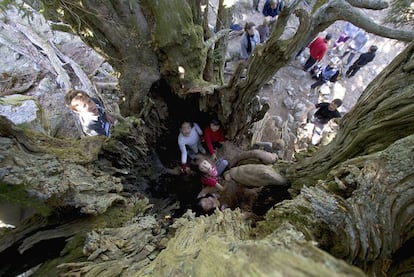New shield for Madrid's oldest tree
Still healthy after a millennium and a half, the yew of Barondillo is drawing growing numbers of visitors, leading to increased concern among conservationists

In a remote ravine in the mountains of Guadarrama, far away from any road, a tree grows. It is a very old tree. Since its seed fell into the earth, some 1,600 years have gone by. As it grew, concealed from sight in the middle of a pine forest, the nearby mountain passes fell consecutively under the control of the Romans, the Visigoths, the Moors and the Christians.
This tree is a yew, a species that is well known for its longevity.
"We don't know precisely how old this specimen is, but its size and condition suggest that it is no less than 1,600 years old," says José Luis Izquierdo, a botanist at the Natural Park of Peñalara, where the yew grows.
Izquierdo says that the yew is without a doubt the oldest living being in the entire Madrid region.
Juan Vielva, the park director, walks down the narrow path that crosses the Barondillo brook ? which lends its name to the yew, known as El tejo de Barondillo ? and reaches the small clearing in the pine forest where the ancient tree grows.
At the end of a summer day, this is a privileged spot indeed. A light breeze is blowing and the air is heavy with the scent of the pines that cover the hillside. The only sound is the babbling of the brook, which still carries water. The only glitch is, it takes a two-hour hike to get here via the shortest route.
Vielva explains that this tree's fame has grown in recent times. "Because of its presence in books about unique trees in Spain and newspaper stories, in the last two years there has been an increase in visitors."
Still, the numbers are not huge. "Now [the tree] maybe gets 500 visitors a year, while before that it was barely 80," says Vielva. Even so, this rise was starting to affect the yew.
"Tourists would go inside the trunk and pull off bits of roots and branches to take home as souvenirs. By walking near it, they also packed the earth tight, damaging the roots."
Consequently, park authorities decided to act. The yew is now protected by a stone wall at a cost of approximately 7,000 euros, which was provided by the savings bank La Caixa. The wall is low, however, and there is nothing to stop somebody from jumping it. This was deliberate, says Vielva.
"We are hoping that people who come all the way here are already sensitive to their natural environment and that they will respect the wall," he says, adding that he did not want to put the yew in a cage.
Not everyone has appreciated the initiative. Ignacio Abella, a tree specialist and writer, writes in his blog La memoria del bosque that the wall has affected "the esthetic view" of the old tree, and that it has also damaged its root system. Abella argues that the number of visitors should have been restricted rather than building an inappropriate fence in a natural space.
Vielva, the park director, is aware of these arguments but disagrees with those opposed to the fence, saying that it is good for the public to "get to know the tree and understand its natural value."
He notes: "You can't do that if you prohibit people from looking at it. No part of the tree has been damaged."
The Barondillo tree produces fruit ? "it is actually a female," says Izquierdo ? and the amount and quality of the fruit indicates that "she is in good health."
Near the fence there is a male yew. "But he is barely 1,000 years old, a mere youth compared to her," laughs Izquierdo.
Tu suscripción se está usando en otro dispositivo
¿Quieres añadir otro usuario a tu suscripción?
Si continúas leyendo en este dispositivo, no se podrá leer en el otro.
FlechaTu suscripción se está usando en otro dispositivo y solo puedes acceder a EL PAÍS desde un dispositivo a la vez.
Si quieres compartir tu cuenta, cambia tu suscripción a la modalidad Premium, así podrás añadir otro usuario. Cada uno accederá con su propia cuenta de email, lo que os permitirá personalizar vuestra experiencia en EL PAÍS.
¿Tienes una suscripción de empresa? Accede aquí para contratar más cuentas.
En el caso de no saber quién está usando tu cuenta, te recomendamos cambiar tu contraseña aquí.
Si decides continuar compartiendo tu cuenta, este mensaje se mostrará en tu dispositivo y en el de la otra persona que está usando tu cuenta de forma indefinida, afectando a tu experiencia de lectura. Puedes consultar aquí los términos y condiciones de la suscripción digital.








































